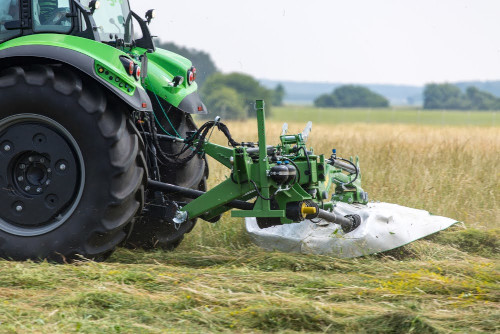How Much Does a Tractor Cost?
How Much Is My Tractor Worth?
Best Tractors for Small Farms
How Much Does a Tractor Tire Weigh?
Most Useful Tractor Implements
Most Popular Tractor Brands
What are Hay Balers?
How Many Bales of Hay Per Acre Can You Produce?
Tractors & Road Safety
What Does PTO Stand for on a Tractor? And How Does It Work?
Compact Vs. Utility Tractors: Which Is Right for Your Farm?
Best Tractor Models for Small to Medium Farms
How To Operate a Skid Steer
Skid Steer Attachments
Manure Spreaders
Grapple Buckets
How Do Combine Harvesters Work?
Autonomous Tractors
Considering a Stocker Cattle Operation?
What is an Excavator?
How much does a Forklift Cost?
How Much Does a Bulldozer Weigh?
Different Types Of Cattle Barns
How Is Hemp Harvested?
How Does a Concrete Crusher Work? Understanding the Role and Mechanisms of Concrete Crushers
A Beginner’s Guide to Online Farm Equipment Auctions
How to Harvest Basil in Your Farm or Garden
How Online Farm Auctions Are Transforming the Ag Industry
Corn Harvesting: Where Is Corn Grown in the U.S.?
How to Write Off Farm Equipment on Taxes
Bale Beds for Sale New & Used
Guide to Tillage: What Is Tillage Equipment & Its Process?
Evolution of the Bulldozer
Bulldozers in Construction
How Cinnamon Is Harvested
Selling Used Farm Equipment
Understanding Commodity Price Trends
Top Tips for Successful Bidding in Online Farm Equipment Auctions
Most Efficient Corn Harvesting
Top Seeders for No-Till Farming
Square vs Round Balers
Understanding PTO on a Tractor: What It Is and How It Works

Farm tractors are known for their ability to power a variety of implements, from mowers and tillers to balers and post hole diggers. But what makes this power transfer possible? That’s where the Power Take-Off (PTO) system comes into play.
A tractor’s PTO is the connection point between the engine and external equipment, allowing implements to function using the tractor’s power. Whether you’re running a rotary cutter, spreader, or auger, understanding how PTO systems work and how to choose the right PTO-powered equipment is essential for efficient farming.
What Is PTO on a Tractor and Why Is It Important?
PTO stands for Power Take-Off, a system that transfers mechanical power from the tractor’s engine to an implement. Without it, farmers would need self-powered attachments, which would be far less efficient and more costly.
By using a PTO, a tractor can drive various implements, making it a versatile and essential machine for any farm operation. Whether you’re tilling soil, baling hay, or spreading fertilizer, your tractor’s PTO delivers the power needed to get the job done.
While the PTO is crucial for operating equipment, it’s not the primary connection point—that’s the three-point hitch. The PTO simply provides power, while the hitch secures the implement to the tractor.
Types of PTO Systems on a Tractor

Not all tractors have the same type of PTO. Understanding which PTO system your tractor uses is key to ensuring compatibility with your implements.
Location-Based PTO Types
Depending on where the PTO shaft is located, tractors can have:
- Rear PTO (most common) – Found at the back of the tractor, used for tillers, mowers, balers, and augers.
- Mid PTO – Located underneath the tractor, often used for belly mowers and front-end attachments.
- Front PTO – Less common, typically used for snowblowers or front-mounted implements.
PTO Connection Types
The PTO shaft must securely connect to the implement’s drive system. Two common PTO connection types include:
- Spline PTOs – These have grooves (splines) that fit into corresponding slots on the implement’s shaft. The 6-spline (540 RPM) and 21-spline (1000 RPM) configurations are the most common.
- Round PTOs – These use a smooth drive shaft with pinholes for locking in place rather than splines.
Matching the right PTO shaft size and RPM speed is crucial for proper operation.
Operational PTO Types
Different tractors use different PTO engagement mechanisms:
- Independent PTO – Works at any speed, whether the tractor is moving or stationary.
- Live PTO – Uses a two-stage clutch, allowing the PTO to operate separately from the tractor’s movement. Ideal for baling hay.
- Transmission-Driven PTO – Only works when the tractor is moving. Common for mowers and spreaders.
- Ground-Speed PTO – Synchronizes implement speed with tractor speed, useful for tillers and planters.
- Economy PTO – Runs at a lower RPM to save fuel and reduce engine wear while operating attachments.
Knowing which type of PTO system your tractor has ensures you purchase compatible implements that will work efficiently.
How Does PTO Work on a Tractor?
Once an implement is connected to the tractor’s PTO shaft via a spline or round drive, the PTO transfers mechanical energy from the tractor’s engine through the gearbox and into the implement.
The operator engages the PTO using a lever, clutch, or electronic switch, depending on the tractor model. The rotation speed (RPM) of the PTO determines how fast the implement operates.
Common PTO Speeds & Uses:
- 540 RPM (6-spline PTO) – Standard for smaller and mid-sized tractors, powering rotary cutters, hay rakes, and augers.
- 1000 RPM (21-spline PTO) – Found on higher-horsepower tractors, used for large balers, spreaders, and high-powered tillers.
Matching the PTO speed with the implement’s recommended RPM rating is critical for optimal performance and equipment longevity.
PTO Safety: Avoiding Common Hazards
A spinning PTO shaft can be extremely dangerous if not handled properly. PTO-related accidents cause serious injuries every year, often due to loose clothing, unguarded PTO shafts, or improper handling.
To stay safe, always follow these best practices:
- Never step over a rotating PTO shaft – Many accidents happen when farmers try to cross over an active implement.
- Wear fitted clothing – Loose jackets, long sleeves, or dangling drawstrings can get caught in the spinning shaft.
- Use a PTO guard – Always ensure the PTO shield or guard is in place when not in use.
- Shut off the tractor before adjusting the implement – Even a disengaged PTO can still rotate slightly.
- Keep children and bystanders away – PTO shafts operate at high speeds, creating a dangerous zone around them.
Understanding PTO safety is just as important as knowing how to operate it. A moment of caution can prevent serious injuries. Learn more about PTO safety.
Choosing the Right PTO Implement for Your Tractor
When purchasing a PTO-powered implement, one of the first things to check is whether it matches your tractor’s PTO specifications. While most PTOs provide a standard connection, there are variations in:
- Spline type (6-spline, 21-spline, or other configurations)
- PTO shaft size and diameter
- RPM rating (540 or 1000 RPM)
Most modern PTO implements list their compatibility details in their specifications. If you’re unsure, check with the dealer or manufacturer before purchasing.
In addition to PTO compatibility, consider your tractor’s horsepower. If your tractor doesn’t have enough horsepower to run a large implement, it won’t perform efficiently—even if the PTO connection matches.
Find PTO Implements for Your Tractor at Fastline
Looking for the right PTO-powered implement for your farm? Fastline’s extensive equipment listings include mowers, balers, tillers, post hole diggers, and more, all compatible with top tractor brands like John Deere, Kubota, Case IH, New Holland, Massey Ferguson, and Mahindra.
Find the perfect PTO implement for your tractor today on Fastline’s equipment listings!